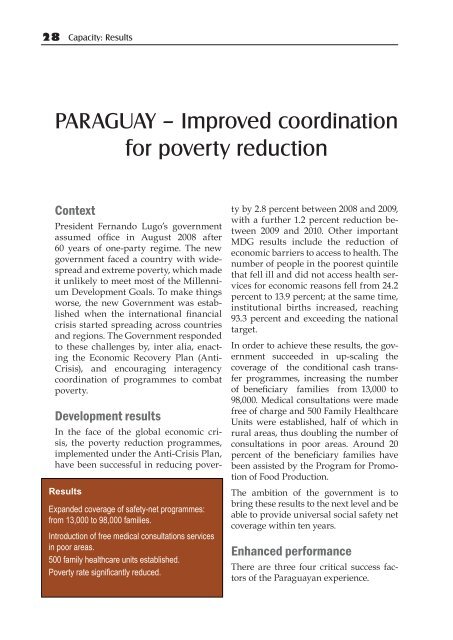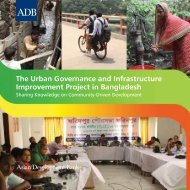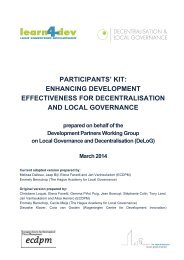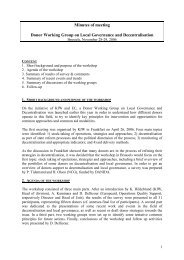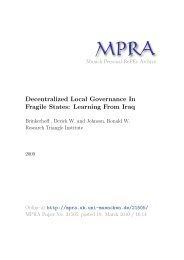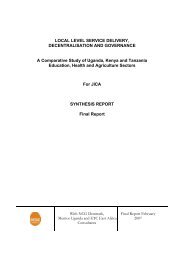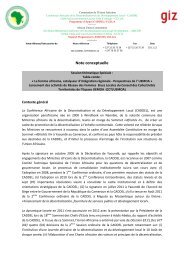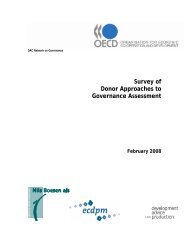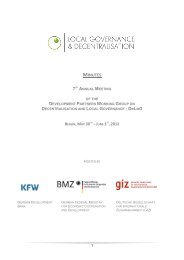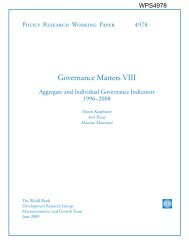Case stories on capacity development and sustainable results
Case stories on capacity development and sustainable results
Case stories on capacity development and sustainable results
Create successful ePaper yourself
Turn your PDF publications into a flip-book with our unique Google optimized e-Paper software.
28 Capacity: ResultsParaguay – Improved coordinati<strong>on</strong>for poverty reducti<strong>on</strong>C<strong>on</strong>textPresident Fern<strong>and</strong>o Lugo’s governmentassumed office in August 2008 after60 years of <strong>on</strong>e-party regime. The newgovernment faced a country with widespread<strong>and</strong> extreme poverty, which madeit unlikely to meet most of the MillenniumDevelopment Goals. To make thingsworse, the new Government was establishedwhen the internati<strong>on</strong>al financialcrisis started spreading across countries<strong>and</strong> regi<strong>on</strong>s. The Government resp<strong>on</strong>dedto these challenges by, inter alia, enactingthe Ec<strong>on</strong>omic Recovery Plan (Anti-Crisis), <strong>and</strong> encouraging interagencycoordinati<strong>on</strong> of programmes to combatpoverty.Development <strong>results</strong>ResultsExp<strong>and</strong>ed coverage of safety-net programmes:from 13,000 to 98,000 families.Introducti<strong>on</strong> of free medical c<strong>on</strong>sultati<strong>on</strong>s servicesin poor areas.500 family healthcare units established.Poverty rate significantly reduced.In the face of the global ec<strong>on</strong>omic crisis,the poverty reducti<strong>on</strong> programmes,implemented under the Anti-Crisis Plan,have been successful in reducing povertyby 2.8 percent between 2008 <strong>and</strong> 2009,with a further 1.2 percent reducti<strong>on</strong> between2009 <strong>and</strong> 2010. Other importantMDG <strong>results</strong> include the reducti<strong>on</strong> ofec<strong>on</strong>omic barriers to access to health. Thenumber of people in the poorest quintilethat fell ill <strong>and</strong> did not access health servicesfor ec<strong>on</strong>omic reas<strong>on</strong>s fell from 24.2percent to 13.9 percent; at the same time,instituti<strong>on</strong>al births increased, reaching93.3 percent <strong>and</strong> exceeding the nati<strong>on</strong>altarget.In order to achieve these <strong>results</strong>, the governmentsucceeded in up-scaling thecoverage of the c<strong>on</strong>diti<strong>on</strong>al cash transferprogrammes, increasing the numberof beneficiary families from 13,000 to98,000. Medical c<strong>on</strong>sultati<strong>on</strong>s were madefree of charge <strong>and</strong> 500 Family HealthcareUnits were established, half of which inrural areas, thus doubling the number ofc<strong>on</strong>sultati<strong>on</strong>s in poor areas. Around 20percent of the beneficiary families havebeen assisted by the Program for Promoti<strong>on</strong>of Food Producti<strong>on</strong>.The ambiti<strong>on</strong> of the government is tobring these <strong>results</strong> to the next level <strong>and</strong> beable to provide universal social safety netcoverage within ten years.Enhanced performanceThere are three four critical success factorsof the Paraguayan experience.


